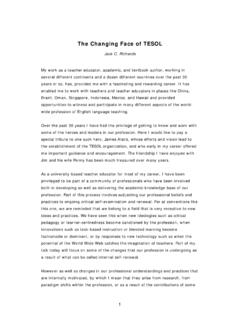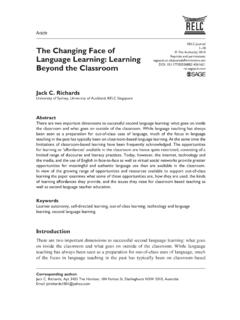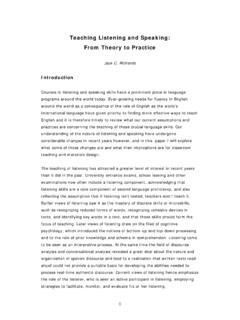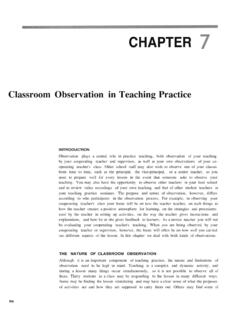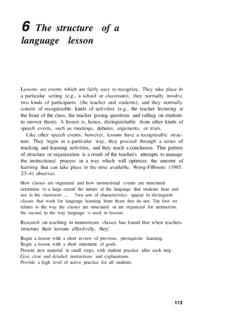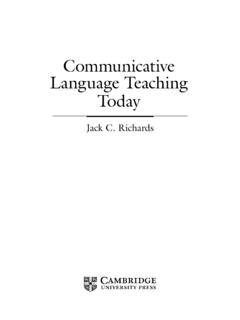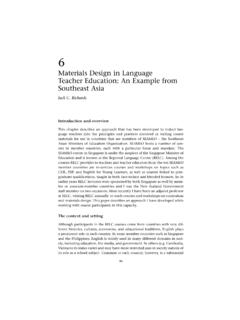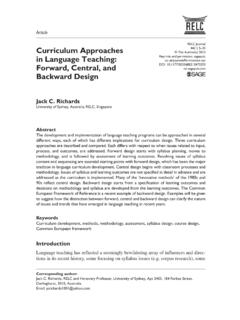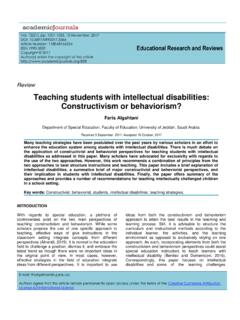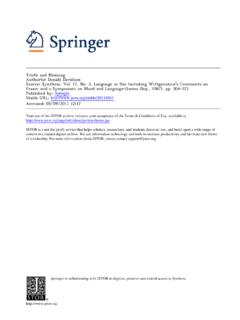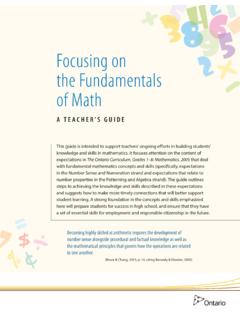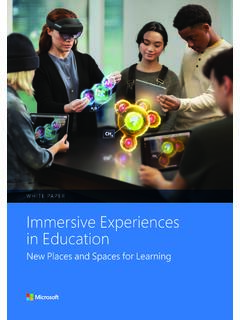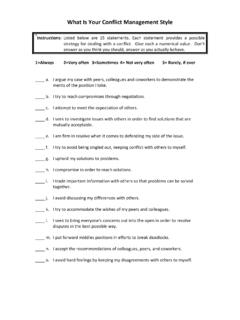Transcription of DEVOPING CLASSROOM SPEAKING ACTIVITIES;
1 Developing CLASSROOM SPEAKING Activities; From Theory to Practice Jack C Richards The mastery of SPEAKING skills in English is a priority for many second or foreign language learners. Learners consequently often evaluate their success in language learning as well as the effectiveness of their English course on the basis of how well they feel they have improved in their spoken language proficiency. Oral skills have hardly been neglected in EFL/ESL courses (witness the huge number of conversation and other SPEAKING course books in the market) though how best to approach the teaching of oral skills has long been the focus of methodological debate. Teachers and textbooks make use of a variety of approaches, ranging from direct approaches focusing on specific features of oral interaction ( turn-taking, topic management, questioning strategies ) to indirect approaches which create conditions for oral interaction through group work, task work and other strategies (Richards 1990).
2 Advances in discourse analysis, conversational analysis, and corpus analysis in recent years have revealed a great deal about the nature of spoken discourse and how it differs from written discourse (McCarthy and Carter 1997). These differences reflect the different purposes for which spoken and written language are used. Jones (1996,12) comments: In SPEAKING and listening we tend to be getting something done, exploring ideas, working out some aspect of the world, or simply being together. In writing we may be creating a record, committing events or moments to paper. Research has also thrown considerable light on the complexity of spoken interaction in either a first or second language. Luoma (2004) for example, cites some of the following features of spoken discourse.
3 Composed of idea units (conjoined short phrases and clauses) May be planned ( a lecture) or unplanned ( a conversation) Employs more vague or generic words than written language Employs fixed phrases, fillers and hesitation markers Contains slips and errors reflecting on-line processing Involved reciprocity ( interactions are jointly constructed) Shows variation ( between formal and casual speech), reflecting speaker roles, SPEAKING purpose, and the context 1 In designing SPEAKING activities or instructional materials for second or foreign language teaching it is also necessary to recognize the very different functions SPEAKING performs in daily communication and the different purposes for which our students need SPEAKING skills.
4 Functions of SPEAKING Numerous attempts have been made to classify the functions of SPEAKING in human interaction. Brown and Yule (1983) made a useful distinction between the interactional functions of SPEAKING (in which it serves to establish and maintain social relations), and the transactional functions (which focus on the exchange of information). In workshops with teachers and in designing my own materials I use an expanded three part version of Brown and Yule s framework (after Jones 1996 and Burns 1998): talk as interaction: talk as transaction: talk as performance. Each of these speech activities are quite distinct in terms of form and function and require different teaching approaches. 1. Talk as interaction This refers to what we normally mean by conversation and describes interaction which serves a primarily social function.
5 When people meet, they exchange greetings, engage in small talk and chit chat, recount recent experiences and so on because they wish to be friendly and to establish a comfortable zone of interaction with others. The focus is more on the speakers and how they wish to present themselves to each other than on the message. Such exchanges may be either casual or more formal depending on the circumstances and their nature has been well described by Brown and Yule (1983). The main features of talk as interaction can be summarized as follows: Has a primarily social function Reflects role relationships Reflects speaker s identity May be formal or casual Uses conversational conventions Reflect degrees of politeness Employs many generic words Uses conversational register Is jointly constructed 2 Some of the skills involved in using talk as interaction are: Opening and closing conversations Choosing topics Making small-talk Recounting personal incidents and experiences Turn-taking Using adjacency-pairs Interrupting Reacting to others Examples of these kinds of talk are.
6 Chatting to an adjacent passenger during a plane flight (polite conversation that does not seek to develop the basis for future social contact) Chatting to a school friend over coffee (casual conversation that serves to mark an ongoing friendship) A student chatting to his or her professor while waiting for an elevator (polite conversation that reflects unequal power between the two participants) Telling a friend about an amusing weekend experience, and hearing her or him recount a similar experience he or she once had (sharing personal recounts) mastering the art of talk as interaction is difficult and may not be a priority for all learners. However students who do need such skills and find them lacking report that they sometimes feel awkward and at a loss for words when they find themselves in situation that requires talk for interaction.
7 They feel difficulty in presenting a good image of themselves and sometimes avoid situations which call for this kind of talk. This can be a disadvantage for some learners where the ability to use talk for conversation can be important. 2. Talk as transaction This type of talk refers to situations where the focus is on what is said or done. The message is the central focus here and making oneself understood clearly and accurately, rather than the participants and how they interact socially with each other. In transactions, .. talk is associated with other activities. For example, students may be engaged in hand-on activities [ in a science lesson] to explore concepts associated with floating and sinking.
8 In this type of spoken language students and teachers usually focus on meaning or on talking their way to understanding. Jones 1996, 14 Burns distinguishes between two different types of talk as transaction. One is situations where the focus is on giving and receiving information and where the participants focus primarily on what is said or achieved ( asking someone for the 3time). Accuracy may not be a priority as long as information is successfully communicated or understood. The second type are transactions which focus on obtaining goods or services, such as checking into a hotel. Examples of these kinds of talk are: CLASSROOM group discussions and problem solving activities. A class activity during which students design a poster.
9 Discussing needed repairs to a computer with a technician Discussing sightseeing plans with a hotel clerk or tour guide Making a telephone call to obtain flight information . Asking someone for directions on the street. Buying something in a shop Ordering food from a menu in a restaurant. The main features of talk as transaction are: It has a primarily information focus The main focus is the message and not the participants Participants employ communication strategies to make themselves understood There may be frequent questions, repetitions, and comprehension checks There may be negotiation and digression Linguistic accuracy is not always important Some of the skills involved in using talk for transactions are: Explaining a need or intention Describing something Asking questioning Confirming information Justifying an opinion Making suggestions Clarifying understanding Making comparisons Agreeing and disagreeing 3.
10 Talk as performance The third type of talk which can usefully be distinguished has been called talk as performance. This refers to public talk, that is, talk which transmits information before an audience such as morning talks, public announcements, and speeches. 4 Spoken texts of this kind according to Jones (1996,14), ..often have identifiable generic structures and the language used is more predictable..Because of less contextual support, the speaker must include all necessary information in the text hence the importance of topic as well as textual knowledge. And while meaning is still important, there will be more emphasis on form and accuracy. Talk as performance tends to be in the form of monolog rather than dialog, often follows a recognizable format ( a speech of welcome) and is closer to written language than conversational language.
